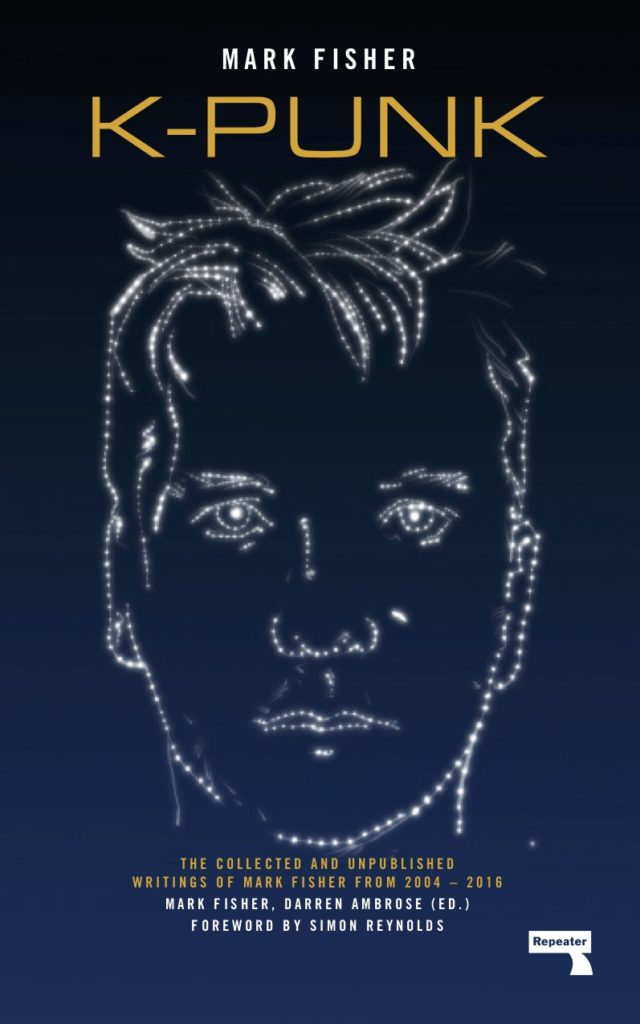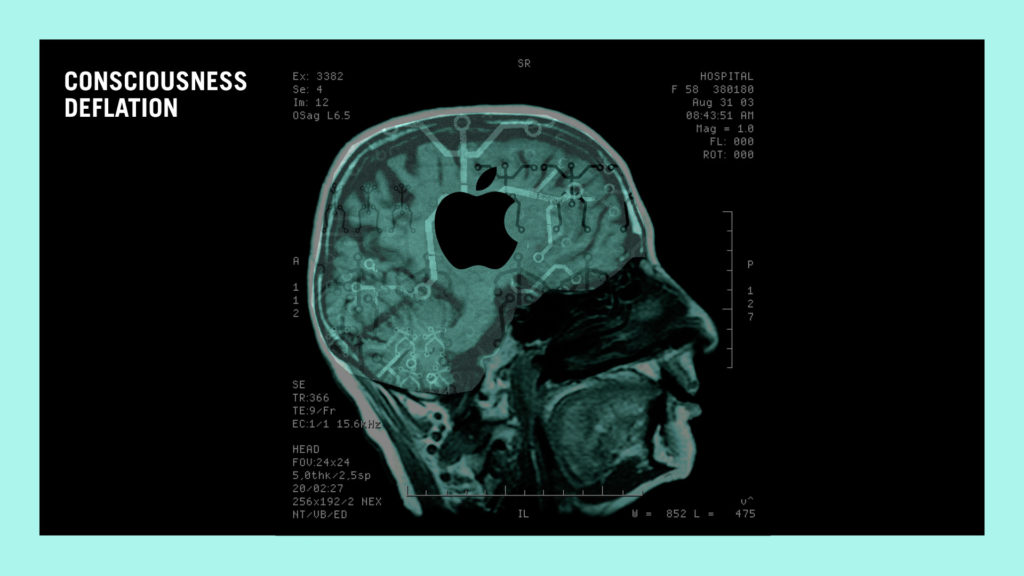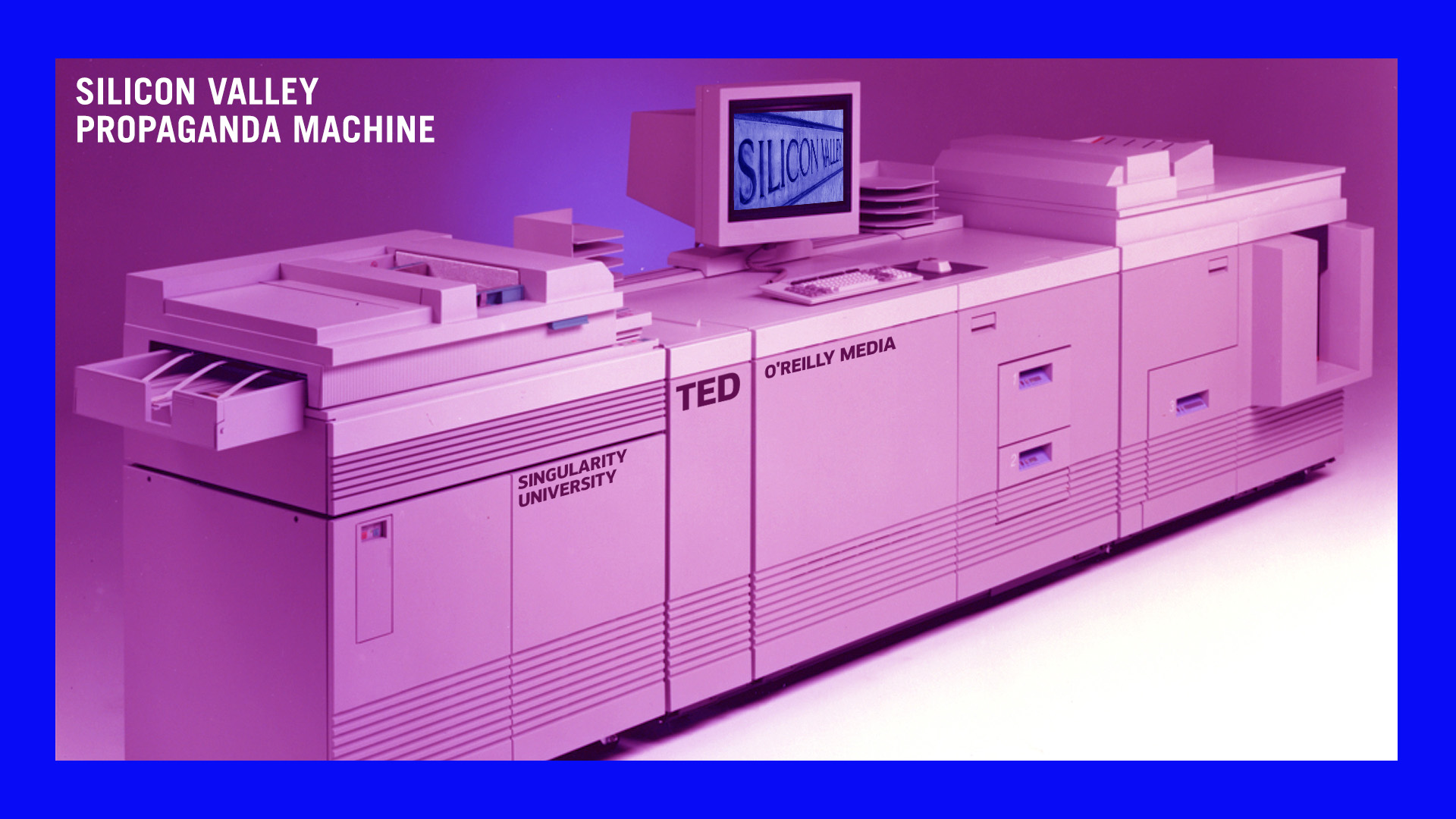The first issue of Making & Breaking delves into questions on the role of cultural production as a contributing force for emancipatory social transformation. This is an urgent and difficult question today, given the ways through which much cultural production lubricates neoliberal operations since the 1980’s (especially it’s spurring of inequality); including the plight of critical practices whose modes of antagonism are frequently subsumed. As a result of decades-long policies, many systems of cultural production increasingly mirror or inadvertently participate in ideological machines supporting the status quo, foreclosing on just resource distribution, human well-being, not to mention our very planet.

k-punk: The Collected and Unpublished Writings of Mark Fisher (2004-2016), from Repeater Books.
It is against these tendencies that Making & Breaking probes modes of cultural production that engage with questions of social transformation. How can our current models for understanding art and cultural production be refashioned, and reconceived to live up to the claims of contributing to debates on social betterment? How can they help to redirect libidinal energies, that are often today co-opted by what Mark Fisher termed digital machines of “consciousness deflation”1, to take on new formulations of futural desire and attachment? How does the category of human experience figure in our global plight, in view of the impersonalization that comes with increasing complexity?
In the first issue of Making & Breaking artists, curators and theorists reflect on these questions across a wide spectrum of cultural production and geographies. In a sense, the issues we raise are already ruminated in the title Making & Breaking. What interests us are forms of “making” within the fields of culture and the arts that help “break” the deadlock our societies seem to be caught in presently. How can cultural “makers” help create the social imagination capable of moving us beyond a contemporary condition whose economic and political operating systems seem to have put us on a trajectory whose potential outcome is the annihilation of the human species and the destruction of the planet?

Image by Ivo Schmets
Making & Breaking, is indicative of some of the contradictions the question of transformative cultural production entails in our present condition. Let’s start with its first part, making. This might appear to be an innocent reference to the fact that something is being made, that a creative process takes place at whose end something has passed from nonbeing into being (what philosophers call poiesis). Yet, if we look more closely at the increasingly ubiquitous use of the notion of “making” and “makers” within the field of culture and the arts today, what comes into view is something much less innocuous and self-evident. Over the course of the last decade, artists and cultural producers began to refer to themselves as makers. Why did they do that? After all, the discourse surrounding creative industries and creative cities had already transformed them into “creatives”, thereby aligning cultural and artistic production to commercial goals and economic targets of correlating development policies. Did they think that they needed an even more generic term than “creative” in order to communicate their professional identity? Probably not. Rather, the surge in popularity of the terms maker and making coincided with the rise of another social phenomenon, that of the so-called makers movement. The latter originated in Silicon Valley sometime in the noughties as a more hardware-orientated update of the Do-It-Yourself (DIY) and hackers culture. Touting revolutionary claims about openness, accessibility and technological progress, it quickly became an element of the “Californian Ideology”2, i.e., the believe that in the “digital age” values such as democracy, freedom and emancipation were no longer best achieved through politically activism and collective organizing but could be left to the tech-savvy consumer who now held (and continues to hold) a great deal of power.

Image by Ivo Schmets
Today, this ideological myth has been thoroughly debunked; most forcefully by wave after wave of revelations about governments and tech-giants abusing power on a scale that would make Shakespearian tyrants blush. We now understand that the euphoria surrounding the blessings of digital innovation – be it democratization through social media, participatory citizenship through the Internet of Things, or economic emancipation through the sharing economy – were no more than myths propagated by the IT-industry and peddled through purpose-built, false hope infrastructures, such as TED. Simultaneously, the achievements of Fab-labs, hackathons and hacker spaces remained far behind the revolutionary ambitions they heralded upon their often subsidized arrival.3 Yet despite – or perhaps rather because of this failure –, the makers movement and its institutions have been seamlessly integrated into the policy machines driving creative industries and creative cities, colonizing whatever remains of public space with their colorful sameness and hip monotony.
The rhetorical transfer of “making” and “makers” from the shallows of Silicon Valley inspired techno-ideology to the sphere of culture and the arts is yet another attempt to implant cultural production firmly within the confines of business logic. Artists and cultural producers are nudged away from a self-definition as aesthetic speculators to that of innovators. The difference here is that the former understand themselves as struggling for a (semi-)autonomous position from which our social sensorium can be expanded, while the latter consign themselves to the improvement of products and services. Daan Roosegaarde, one of the Dutch champions of the creative industries, unwittingly captures this shift when he refers to his role as an artist/designer in terms of “upgrading reality”.4
The problem highlighted by “makers” captured in the quote above, is less the submission to our economic zeitgeist, but rather the artistic self-diminishment this entails: upgrades follow the linear logic of continuity with slight improvement; existing products may be ameliorated, but are never questioned or challenged unto themselves. As biologist and media theorist Arjen Mulder argues in his contribution to this issue, such entrepreneurial smartness ought not to be the modus operandi of artists. Rediscovering the nearly forgotten Swiss writer and polymath Adrien Turel (1890-1957), Mulder rearticulates a distinction Turel made between two modes of creativity: the genetic and the dynamic. Simply put, in the genetic mode, something new is created while in the dynamic mode, this novelty is spread, “rolled out”, and distributed throughout the world. According to Turel/Mulder, artists (just like inventors) belong to the former mode, entrepreneurs to the latter. There are good reasons for the 21st century reader to approach Turel’s reductive dichotomy of creativity with skepticism. Yet, it remains worthwhile to note that it represents a step forward from the assumption – widespread within today’s creative industries – that all creativity must be entrepreneurial. What Mulder’s piece invites us to consider, is that entrepreneurial creativity is merely one specific mode of bringing something new in the world (to reiterate, poiesis) and that we would lose entire worlds of inventiveness (and, ultimately, innovation) were we to follow the rhetoric of creative industries by equating creativity with entrepreneurialism.
By contrast, Florian Cramer’s piece positions such considerations as hopelessly nostalgic. Cramer’s essay pushes the logic of entrepreneurial making in the art world to its disparaging extreme. According to him, the contemporary art world suffers from a condition best captured as “crapularity”, a notion he derives from the idea of technological singularity (where machinic intelligence is said to surpass that of the human) in which everything that could go wrong does go wrong. For Cramer, the wrong turn in contemporary art lies in the attempt to uphold a notion of autonomy understood as a resistance to commodification. Art today is fully commodified, and for Cramer it has even become a form of capital unto itself. Think of the masses of (crappy) art stored away in vaults and underground airport depots in order to be traded much like the financial “junk” of subprime mortgages that caused the financial crisis of 2008. Or, consider the way in which artistic images fuse with cryptocurrency in order to generate the ephemeral value of a meme. Cramer’s refreshing skepticism functions as a reality check for the contemporary art world. One doesn’t have to follow his conclusions to the letter to understand that the conditions under which art is made, distributed and consumed today make simple proclamations of artistic autonomy seem vacuous and foolish. If something like artistic autonomy remains a possibility at all, it is one that can only be won by a struggle against all kinds of contemporary crapularities.
Max Dovey’s related article, albeit from the perspective of an artist, offers an in-depth analysis of the links between artistic production and technology. As an artist whose work engages with the opportunities and challenges of digital technologies, Dovey investigates the meme art hype, i.e., the fashionable connection between cryptocurrencies and artistic practice. Through a fascinating discussion peppered with a host of examples, Dovey raises an important question as to what it means for artists to get involved with the creative industries in general, and technological innovation in particular. He questions the often naïve and opportunistic attitudes of artists when encountering new technologies, since such practices bend towards a regurgitation of the industry’s techno-euphoria, rather than a critical and inventive engagement with the technology itself. Dovey urges his artist colleagues to develop the insight and tech-savviness that would allow them to become more than meme-artists, i.e., artists that are able to sovereignly experiment with and shape these (in this case financial) technologies so they can better serve the arts and culture more broadly.
The art world merely represents a part of the system of cultural production. Since the advent of Postmodernism, serious doubt has been shed on the elevated position of art (what’s commonly described as visual arts) with respect to the ability to distance itself from the parameters set by neoliberal politics and economics, let alone resist, or, indeed, to break with them.5 Yet this moment of the supposed decline of (high) art in the traditional sense has coincided with a veritable explosion in cultural production more generally. So the question for this issue of Making & Breaking, is this: where in this field can we detect (the seeds of) imaginative practices that point beyond what Fisher poignantly called “capitalist realism”6? He used the notion of capitalist realism in order to describe an ideological atmosphere dominated by the idea that there is no alternative to the current practice of organizing every activity in society as though it were a business. It is from here that we reach the second part of our title, breaking. Like Fisher, who was a radiantly intense commentator on popular culture, we’re searching for aesthetic manifestations of social propensities that would break with and point beyond the limitations of the contemporary.7
In this issue, the contribution from Rhian E. Jones most overtly treads in Fisher’s intellectual footsteps in her analysis of the role of grime in relation to the formation of a young oppositional movement in the run-up to the June 2017 snap election in the UK. The question she’s grappling with is: Can music change the world? And while Jones is painfully aware of the complexities and ambivalences that are inherent to the music business – even if, as in the case of grime, it tends to be more of a DIY affair – her answer to the question tends to the positive. Grime’s success was based on the ability to articulate the daily life experience of segments of British youth that are otherwise absent from the media: “the sound of social deprivation emerging from the shadows of re-urbanisation and gentrification”, as she puts it in her article. This experience was able to connect with a kind of politics that dared, once again, to think problems of race and gender together with those of class and economic inequality. So music may not change the world by itself but it can contribute a hell of a soundtrack to an emancipatory political movement.
In other words, context is key. This is also the tone struck in Dulcie Abrahams Altass’ article that analyzes the emancipatory impact of pop music from a different geopolitical perspective. Reflecting on Dakar’s hip-hop scene, she criticizes what she calls the Western art world’s “hip hop turn”, meaning the trendy incorporation of hip hop into shiny museum and gallery spaces thereby making a mockery of hip hop’s pronounced countercultural message. As a contrast to this model of cooptation, Abrahams Altass introduces us to the work of RAW Material Company, an art center in Dakar. Rather than capitalizing on the popularity of hip hop, RAW Material Company chose to approach the genre in a more resolute fashion. Together with local hip hop artists, they created a “Five Elements” program (a reference to the five elements of hip hop), a platform for thinking about hip hop as a force for cultural change. Turning hip hop into a pedagogical tool beyond the traditional dichotomy of high and low art, a cultural practice emerged that challenges both, the conservatism of Senegalese society and the Western approach to (pop) culture. Should one understand such a program in terms of an “opportunity to embrace hip hop as part of a lineage of avant-garde practices within art history”, as the author has it? Perhaps. What is certain, though, is that this West-African fusion of contemporary art and hip hop offers an intelligent model of the art world engaging with a pop cultural phenomenon such as hip hop that is both incredibly political and inventive.
With Katherine Cross’ contribution, the focus shifts towards the intersection of technology and subjectivity, or rather, to the question of what role technology can play in challenging and transgressing ossified norms of subjectivity. More concretely, her article looks at the complexities of gender and power in the gaming industry and how they persist in the indie game world as well. She takes us on a journey through a world of passionate work and passionate play (as ambivalent phenomenon) that unfolds between developers and users of independent videogames, specifically games that cater to the queer community. Somewhat similar to Jones’ argument about grime, she understands the main contribution of such games in terms of “telling authentic stories about marginalized people”. For Cross, games can be tools for the queer community to explore what she calls “the beauty of the imperfect”. She symbolizes this in the figure of the broken avatar, a kind of digital aggregation of the anomalies socially projected onto queer people. Arguing that “the manifest nature of a queer person’s imperfection” her article is a call to embrace the broken avatar in the game “as the truest vision of a digital queer self.”
Benjamin T. Busch and Patricia Reed project the discussion of cultural production and social change to a more general level. Busch’s contribution is an investigation of the extent to which the expansion of computation into everyday life offers opportunities for an emancipatory transformation of our current cultures and architectures of organization. Being critical of hasty celebrations of “networked” or “smart” forms of organization whose supposed non-hierarchical achievements are usually paid off by intensified surveillance and control, Busch suggests an assessment of the promises and perils of computational infrastructure based on “The Stack” model developed by Benjamin Bratton. Busch elaborates on the possibilities of The Stack, and the new geopolitical ‘normal’ it entails, via considerations of human subjectivity, and specifically questions of political autonomy that are irreducible to technological automation alone. Through historical precedents of self-management charted in the work of Henri Lefebvre, and put into practice in the former Yugoslavia (‘samoupravljanje’), Busch pushes for the need to think ‘user-values’ of our platform paradigm, ones that are no longer premised on the infinite exploitation of its very users.
Reed’s essay looks at the interplay between optimism and nihilism, as a way of discussing the root logics and given assumptions that ground our way of being in the world. How can this interplay, she asks, help us understand the logical base through which social organization unfolds? Drawing from Sylvia Wynter’s theoretical work tracing historical epochs through genres of human self-understanding (and how those encode the human in a certain way), she demands a vision of the human commensurate with the scale of the world as a way to refigure political traction anew. According to Reed, the current socio-economic stagnation (described above in terms of capitalist realism) cannot be fundamentally overcome without reconstituting a different logical vision of the concept of being human. As an artist and designer, Reed takes this premise to the field of art, looking at how nihilism can serve as a vehicle to reason through materials (i.e. in the best sense of ‘making’) towards the construction of affective and experiential approaches to the world from the perspective of a different ‘genre’ of being human.
What is at stake for Reed – but also for this issue of Making & Breaking in general – is an approach to cultural production that is conscious of the complex ways in which the arts and culture are embedded in a social ‘operating system’ that excels in its resilience against emancipatory transformation. And this, it seems to me, is what connects the distinct contributions to this issue: to raise the question of cultural production and emancipation not in terms of something that is a given (by virtue of its autonomy etc.) but rather, as a conscious struggle against the systemic forces that keep change trapped in the tyranny of relative sameness – from capitalist realism down to our very vision of humanity.

